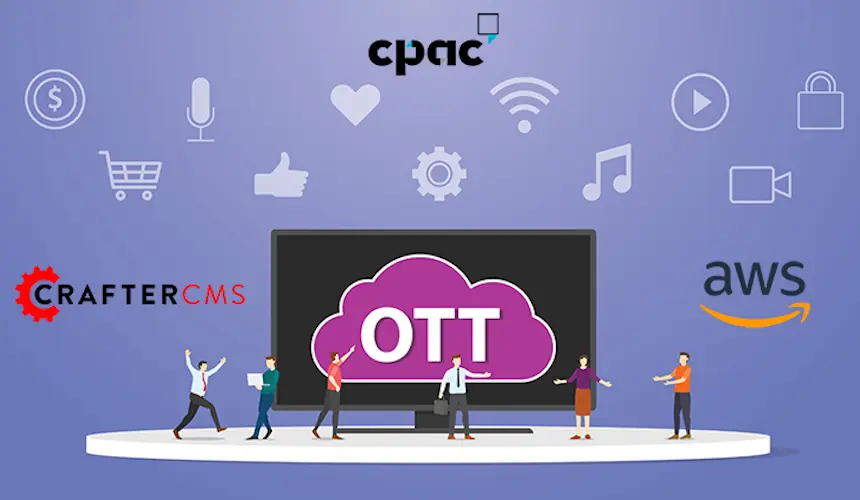Getting More From Next.js With a Headless CMS

Sara Williams

In an ever-evolving world of front-end developer frameworks, Next.js is an achiever. Prerendering allows developers to build sites faster with React, putting the essentials of advanced React development at their fingertips.
However, while Next.js offers powerful capabilities, organizations still need a way to manage the content for any and all Next.js-based applications. This is where a headless CMS proves beneficial.
In this article, we'll highlight some of the new and innovative features that Next.js offers and explain how businesses can get even more than they bargained for out of those features with a platform like CrafterCMS.
What Is Next.js?
Next.js is a flexible React framework created by Vercel that provides developers with building blocks to create fast and efficient web applications. It handles the configuration and tooling required for React and offers additional features, structures, and optimizations for your application. Next.js packs a bundle of perks that make it the ideal development environment for developers and marketers.
Next.js provides the flexibility to build static web applications and server-side rendering using React. The combined capabilities of the two methodologies help deliver a faster and smoother user experience while improving the website's SEO rankings. The framework receives constant updates, with Vercel releasing Next.js version 13 in October 2022, enhancing its functionality and extending the already-rich feature library. Let's discuss some of the latest key additions below.
Next.js Latest Features
While Next.js is already known for increasing speed, scalability and performance, it also includes newer features that make it even better.
Turbopack: Turbopack is a new bundler for Javascript applications that comes with Next.js 13. It is built using RUST, improving efficiency over its predecessor, Webpack. According to Vercel, Turbopack delivers 700x faster performance over Next.js 12 due to optimized asset bundling and RUSTs efficient memory processing. The newly introduced bundler speeds up the development journey manifold, making it essential for developers.
OG Image Generation: Open graph (OG) images are social cards that appear on social media platforms where content is shared. Social cards significantly impact user engagement, making them vital for marketers and content creators. However, dynamic social cards computed at runtime are very resource-intensive and time-consuming.
Next.js 13 includes a native OG library for social card generation. Vercel's implementation of the OG library displays 5x better performance compared to existing solutions. This is primarily due to the shift from Chromium, which has become very intensive over the past few years, to Vercel edge functions.
Personalization: Middleware allows implementing personalization entirely on edge. Next.js personalization works at a higher level when combined with static site generation. With Next.js middleware, you can implement personalization in a way that is easy for developers and highly performant for users.
Support for ES Modules and URL Imports: Next.js includes the experimental support to import ES modules via URLs without needing a separate build. URL imports are basically an experimental feature allowing you to import modules from external servers directly instead of the local disk. They work similarly to a CDN and provide a cleaner application directory structure and a smoother working experience for developers.
Instant HMR and Builds: Vercel allows developers to see reactions to changes promptly. A priority in Next.js since the beginning, the new functionality builds support for webpack HMR with zero configuration. It leads to the development of fast refresh innovation in Next.js. Fast refresh reflects changes made to the application almost instantly, providing an enhanced development experience.
Significant Workflow and Collaboration Innovations: Next.js live (beta) enhancements provide significant workflow and collaboration innovations. It runs natively inside a web browser, boosts up promptly, and lets anyone with the link collaborate.
What Are the Benefits of Using Next.js?
Next.js is the top choice for developers working with React. The reason is that it's an open-source framework and easy to use. Moreover, it provides a seamless developer experience by simplifying and accelerating build times. Here are some of the most common advantages of Next.js.
Server-side Rendering (SSR): Next.js allows server-side rendering, which means users can view the HTML content on the user-facing applications directly since it loads everything from the server. Therefore, the user experiences less loading time. Moreover, server-side rendering provides SEO benefits with search engine indexes and crawls the website directly, as no client-side Javascript is needed. SSR adds to the user experience, all the while boosting SEO rankings.
Automatic Code Splitting: Next.js only loads the CSS and Javascript whenever required and is relevant to the current page. Therefore, pre-loading time is remarkably faster as the browser does not need to download CSS and Javascript, which are not required to render the page. As a result, users experience lesser latency between requesting and receiving a webpage.
Hot Module Replacement: This feature is helpful to developers but not an issue for end-users. The changes you make during the development are instantly visible in the production with HMR. Thus, it maintains the application's integrity and dramatically reduces the time needed for changes to take effect as opposed to conventional methods. It positively impacts the client as less time is spent on development due to a faster and more efficient process.
Using a Headless CMS for Building Next.js Applications
Next.js makes it easier to create fast and scalable React applications with server-side search engine optimization. When it comes to content authoring, combine it with a headless CMS or Next.js CMS, to get even more capabilities.
Content Authoring and Publishing
Next.js provides flexibility and the building blocks required to create fast and efficient applications. Combining Next.js with a headless CMS enables you to develop and leverage functionality such as content authoring/editing and content publishing that non-technical business users need.
Build SEO-friendly and High Performance Websites
Next.js provides a fantastic developer experience with a sprinkle of customized lifecycle methods. Building projects with a Next.js CMS allows teams to create SEO-friendly, high performance websites.
Enable Collaborative Workflows
By separating the front-end from the backend and managing content with predictable content models, a headless CMS allows developers and content editors to work in parallel. Developers can gain the freedom to do what they want with the front-end and create content applications using frameworks like Next.js more easily.
Meanwhile, content authors can nimbly update the content across all channels without developer support, freeing both parties to tackle more work efficiently. It provides a competitive edge for organizations wanting to increase their market speed and utilize their digital team's time efficiently.
Read More: CMS for SPAs: Building NextJS Apps with CrafterCMS 4
CrafterCMS: Get the Most Out of Next.js With a Headless CMS Solution
Next.js is helpful for organizations that need to develop and deploy web offerings instantly while still providing a full-featured platform to build complex applications.
CrafterCMS offers a Git-based, enterprise-class headless CMS for building and running content applications. It provides an API-first content platform with a wide range of APIs and full-featured UX for developers, administrators, and content authors. These capabilities enable developers to fully realize the benefits of their Next.js content-centric applications, while offering content authoring/editing teams an easy to use and powerful content creation experience.
World Class Content Authoring
CrafterCMS delivers a best-in-class authoring experience for marketers and other business users. While developers can build content applications using Next.js, CrafterCMS allows content authors to edit those applications using drag and drop tools, in-context editing and more. They can also preview content on any channel and work on a variety of tasks without interrupting or being reliant on developers.
RESTful and GraphQL APIs
Next.js handles API data efficiently, and combining it with CrafterCMS can be a powerful combination for your tech stack. Unlike a traditional CMS, CrafterCMS is API-driven, built with RESTful and GraphQL APIs to enable efficient developer productivity.
Better Search Experience
With CrafterCMS and its built-in open source search engine, you can make it easier for your Next.js application to filter and query content. Easily create dynamic content experiences with CrafterCMS, React and Next.js.
DevContentOps
Taking full benefit of its Git-based content repository, CrafterCMS unites developers, content teams, and operations through seamless workflows.. Developers always have easy access to the latest production content with a Git “pull”, and can easily “push” new features and updates to QA, staging, and production environments. Content and code can be released together (and rolled back as necessary), facilitating unprecedented collaboration between developers and content authors. Integrate and extend your software CI/CD pipeline, and eliminate problems like code and content freezes that are endemic to traditional database-oriented CMSs.
Git-based Versioning
CrafterCMSs’ Git-based content repository allows content creators to leverage the full power of Git’s versioning capabilities. These include not only version control of content, but also additional branching, auditing and security features without worrying about the technical details.
Flexible Hosting Options
CrafterCMS supports both self-managed (Crafter Enterprise) and SaaS (Crafter Cloud) hosting options. In either case, CrafterCMS can be integrated with Next.js Enterprises may choose to run Next.js natively, or utilize Vercel to host their Next.js server and enjoy its many new features.
CrafterCMS caters to the needs of medium to large enterprises, and fast growing startups that need to scale, keeping both developers and marketers happy and in sync. Learn more about the benefits of CrafterCMS by reading: Seven Reasons Why Crafter Should Be On Your Web CMS Shortlist.
Related Tags
Related Posts

Websites Are Dead?

Mike Vertal

No-Code Experience Building for Marketers & Designers

Amanda Lee

Is Your CMS MACH-Ready? A Practical Guide for Enterprise Architects

Sara Williams

Composable DXP vs Traditional DXP: Why Enterprises Choose CrafterCMS

Amanda Jones
Related Resources
-

CrafterCMS at eBay: The Universal Content Platform for eBay.com
Webcast
-

Personalized Digital Experiences for a Cruise Liner
Webcast
-

Introducing CrafterCMS v4.0
Webcast
-

Modernizing Video Delivery and Content Management at CPAC, A Canadian Nationwide Broadcaster
Webcast
-

Building React Apps on a Headless CMS
White Paper





